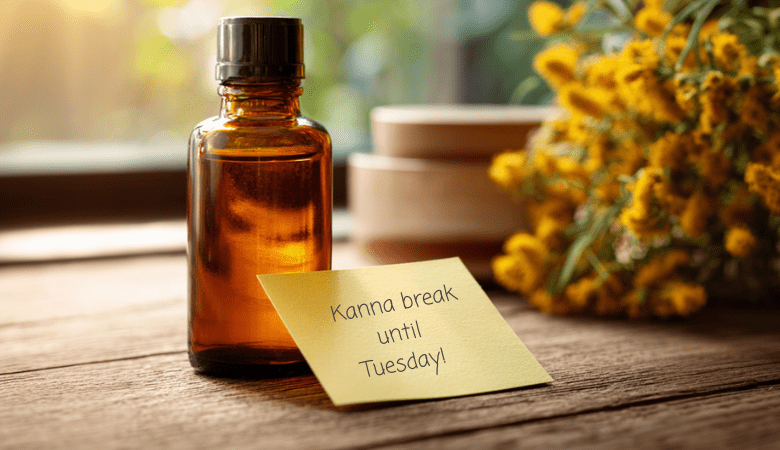Your Cart is Empty
FREE SHIPPING ON ALL ORDERS $75+
Kanna (Sceletium tortuosum) is an herbal supplement traditionally used in South Africa for mood enhancement, relaxation, and focus. It works by influencing serotonin pathways in the brain, producing calming and uplifting effects. However, regular use can lead to tolerance — meaning you might need more Kanna to feel the same results. That’s where aKanna tolerance break comes in.
In this guide, you’ll learn why tolerance happens, how to tell if you need a break, and how to make the most of your reset period, even if you’re new to Kanna.
Regular Kanna use can reduce its effects over time, making a tolerance break beneficial.
A short break can helpreset Kanna sensitivity and restore full benefits.
Listening to your body is key to knowing when to pause and resume safely.
Kanna contains alkaloids like mesembrine that interact with serotonin receptors and inhibit serotonin reuptake (similar to certain antidepressants). This can help boost mood, reduce anxiety, and promote focus without strong hallucinogenic effects.
Common effects include:
Increased relaxation
Sharper focus
Reduced social anxiety
Kanna comes in several forms: raw plant material, tea, capsules, tinctures, and evensmokable powder. If you’re just starting, see ourKanna dosage guide to avoid overuse from the beginning.
Tolerance occurs when your brain adjusts to repeated serotonin modulation. Over time, your receptors may become less responsive, making Kanna’s effects feel weaker.
Factors that can speed up tolerance:
Daily Kanna use without breaks
High doses for extended periods
Combining Kanna with other serotonin-affecting substances
Low natural serotonin levels to begin with
If you’ve been taking Kanna regularly and noticeKanna effects fading, it’s likely time for a break.
Look for these common indicators:
Needing larger doses for the same effect
Feeling little to no mood lift after your usual amount
Reduced focus or relaxation benefits
Mild headaches or irritability after use
Feeling mentally “flat” or unmotivated despite taking Kanna
If multiple signs match your experience, a Kanna dosage break can help restore responsiveness.
Most people benefit from3–14 days without Kanna. The exact length depends on:
How often you’ve been using it
Your dosage level
Your body’s natural reset speed
General guideline:
Light users (2–3 times/week) → 3–5 days off
Moderate users (4–6 times/week) → 7 days off
Heavy daily users → 10–14 days off
Some users report a fullKanna sensitivity reset after just a week, while others need longer. You can also experiment with microdosing Kanna after your break to help maintain results longer.
Taking a break isn’t just about stopping — it’s about supporting your mood and energy in the meantime.
Tips for a smooth tolerance break:
Stay hydrated — dehydration can worsen mood dips.
Eat serotonin-supportive foods like bananas, eggs, turkey, and dark chocolate.
Exercise daily to naturally boost endorphins and serotonin.
Practice relaxation techniques like meditation or deep breathing.
Avoid replacing Kanna with excessive caffeine, alcohol, or other substances.
If you’re using Kanna for anxiety relief or stress reduction, consider non-herbal coping tools during your break so your mental health stays stable.
After your break, you can extend Kanna’s effectiveness by:
Using Kanna only2–4 times per week instead of daily
Rotating between Kanna and other natural mood supports
Taking amini-break every month (2–3 days off)
Keeping doses at thelowest effective amount
You can also read our guide on the best time to take Kanna to help maximize each use without overdoing it.
Kanna is generally considered safe when used in moderation, but new users should:
Start with a low dose to assess tolerance
Avoid mixing it with SSRIs or MAOIs (can cause dangerous serotonin overload)
Use it responsibly and track personal reactions
If you’re brand new to Kanna, you might not need a tolerance break for months — but learning about them early can save you from reduced effects later. Also check whetherKanna is legal in your state before buying.
Research on long-term Kanna use is limited, but moderate use appears to have a low risk of harm. Heavy or prolonged use without breaks may reduce its effectiveness and could potentially impact serotonin balance.
Kanna is mildly psychoactive. It can improve mood and relaxation without strong hallucinations or distortions, making it different from most psychedelics.
Kanna is not considered physically addictive. Some people may develop a psychological habit, especially if they rely on it daily for mood support.
Kanna works by inhibiting serotonin reuptake, which increases serotonin availability in the brain. This promotes relaxation, improved mood, and social ease.
Kanna does not directly deplete serotonin, but frequent high-dose use can cause receptor downregulation, making serotonin less effective until you take a break.
Yes. Some users find that very small, consistent doses help maintain benefits without building significant tolerance, though breaks are still recommended periodically.
Comments will be approved before showing up.
